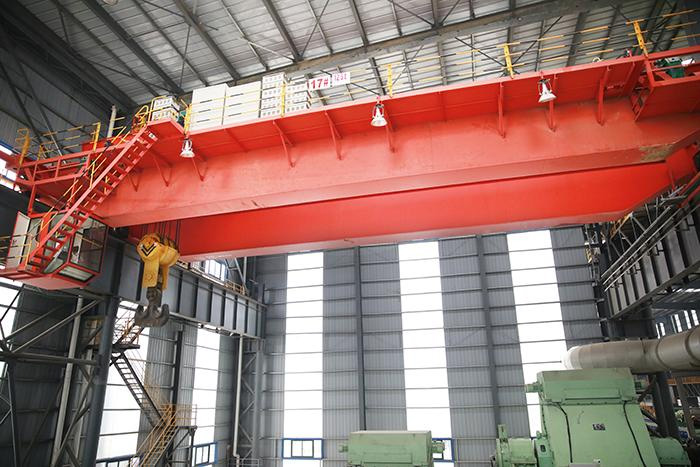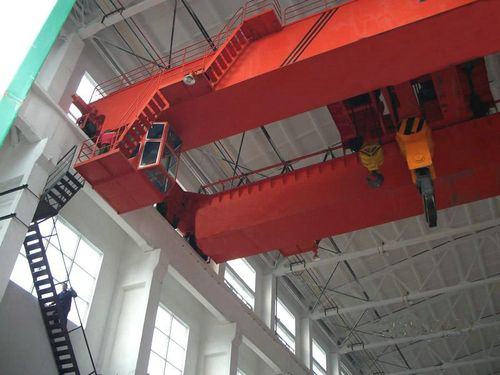The common faults of the main beam of double girder overhead cranes are mainly main beam sinking, and there are many factors affecting the main beam sinking, which can summarize in the following aspects.

There is the stress of different directions and properties in various parts of the metal structure of the double girder overhead crane. Some come from the action of the load. Some are from the manufacturing process, the uneven shrinkage between the welding seam and its nearby metal. During the use of the crane, these stress tend to be homogenized and disappear, causing plastic deformation of the structure.
The influence of crane transportation, storage and hoisting, and unreasonable transportation, storage, hoisting, and installation can cause deformation of the bridge structure.
When the double girder bridge crane is affected by design under certain conditions, the unreasonable use of overload and eccentric load will cause the bridge frame to deform. For example, there is a 75-ton double-girder bridge crane in a factory. Due to frequent overload work, the main girder has sunk by 40mm within three years.
Gas cutting or welding on the bridge, without taking any measures to prevent (explanation: prevention, alert) deformation (referring to the solution to the problem), uneven heating will also cause the deformation of the bridge. The single-girder crane has two types of operation on the ground and in the air. There are two types of ground operation: cable handle operations and remote control handle operations. Aerial operations refer to cab operations. There are two types of driver’s cab, open type and closed type, which can divide into two-type of left or right installations according to the actual situation.
The double-girder bridge crane used in the hot processing workshop is more common than the main beam of crane used in the cold processing workshop, and the degree of sinking is also more severe. The reason is that the radiant heat of smelting will cause the temperature of the lower cover plate of the main beam to be higher than the temperature of the upper cover plate so that the increase of the lower cover plate is higher than that of the upper cover plate. The camber of the main beam will naturally decrease under the load.
Double-girder overhead cranes generally refer to double-girder bridge cranes, usually consisting of three major parts – mechanical, electrical, and metal structure. It has been used widely in indoor and outdoor industrial and mining enterprises, the iron, and steel chemical industry, railway transportation, port terminals, logistics turnover, and other departments and places. For the safe operation of double girder cranes, the following safety routine inspections need to do:
One is to configure some safety devices to ensure safety. Second, various parts and components must meet safety requirements.

(1) The lifting height limiter, travel limit switch, and interlocking mechanism work normally and are safe and reliable.
(2) All main parts meet the safety requirements: the opening increase is less than 15% of the original size, the torsional deformation is less than 10%; the wear of the hook bushing is less than 50% of the original size, the wear of the hook mandrel is less than 5%, and there is no peeling, burr, welding repair. The hook hanger and pulley have no apparent defects. The steel wire wear and corrosion on the surface of the steel wire rope are less than 40% of the diameter of the steel wire, and the broken wire is less than 10% of the total number of wires within a lay length, annealing, burning phenomenon. The ends of the wire rope are connected and fixed with the clips, pressure plates, and wedges in good condition without loosening. There should be no less than two pressure plates and 3 clips. The drum has no cracks, and there is no loose connection and fixation; the wear of the drum wall is less than 20% of the original wall thickness; the safety roll is not less than two turns, and the ratio of the diameter of the drum to the wire rope meets the requirements. The balance wheel is well fixed, and the wire rope should meet the requirements. The brake has no cracks, no looseness, no severe wear, equal size and suitable size on both sides of the brake gap, sufficient braking force, and the wear of the brake band is less than 50% of the original thickness.
The safe routine inspection of double-girder overhead cranes has played a significant role in eliminating personal accidents, reducing equipment accidents, improving equipment operation rate, and reducing maintenance costs.
If you have any inquiry, please feel free to contact us.